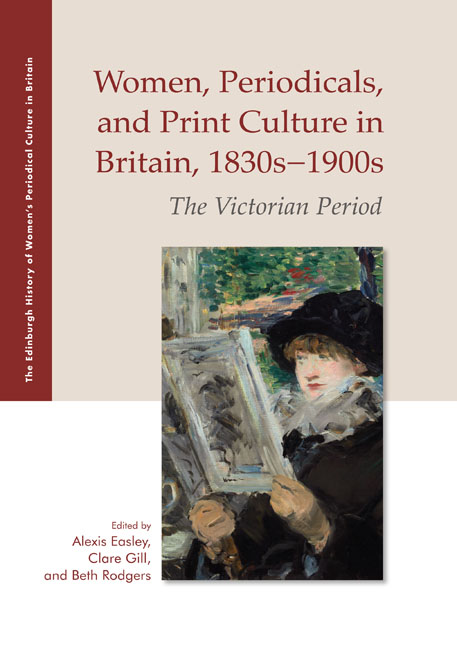Book contents
- Frontmatter
- Contents
- List of Illustrations
- Acknowledgments
- Introduction: Women, Periodicals, and Print Culture in the Victorian Period
- Part I (Re)Imagining Domestic Life
- Part II Constructing Modern Girls and Young Women
- Constructing Modern Girls and Young Women: Introduction
- 7 Promoting a Do-It-Yourself Spirit: Samuel Beeton's Young Englishwoman
- 8 Claiming Medicine as a Profession for Women: The English Woman's Journal's Campaign for Female Doctors
- 9 Encouraging Charitable Work and Membership in the Girls’ Friendly Society through British Girls’ Periodicals
- 10 ‘Welcome and Appeal for the “Maid of Dundee”’: Constructing the Female Working-Class Bard in Ellen Johnston's Correspondence Poetry, 1862–1867
- 11 The Editor of the Period: Alice Corkran, the Girl's Realm, and the Woman Editor
- 12 The ‘Most-Talked-Of Creature in the World’: The ‘American Girl’ in Victorian Print Culture
- Part III Women and Visual Culture
- Part IV Making Space for Women
- Part V Constructing Women Readers and Writers
- Part VI Intervening in Political Debates
- Notes on Contributors
- Index
- Plate section
9 - Encouraging Charitable Work and Membership in the Girls’ Friendly Society through British Girls’ Periodicals
from Part II - Constructing Modern Girls and Young Women
Published online by Cambridge University Press: 25 October 2019
- Frontmatter
- Contents
- List of Illustrations
- Acknowledgments
- Introduction: Women, Periodicals, and Print Culture in the Victorian Period
- Part I (Re)Imagining Domestic Life
- Part II Constructing Modern Girls and Young Women
- Constructing Modern Girls and Young Women: Introduction
- 7 Promoting a Do-It-Yourself Spirit: Samuel Beeton's Young Englishwoman
- 8 Claiming Medicine as a Profession for Women: The English Woman's Journal's Campaign for Female Doctors
- 9 Encouraging Charitable Work and Membership in the Girls’ Friendly Society through British Girls’ Periodicals
- 10 ‘Welcome and Appeal for the “Maid of Dundee”’: Constructing the Female Working-Class Bard in Ellen Johnston's Correspondence Poetry, 1862–1867
- 11 The Editor of the Period: Alice Corkran, the Girl's Realm, and the Woman Editor
- 12 The ‘Most-Talked-Of Creature in the World’: The ‘American Girl’ in Victorian Print Culture
- Part III Women and Visual Culture
- Part IV Making Space for Women
- Part V Constructing Women Readers and Writers
- Part VI Intervening in Political Debates
- Notes on Contributors
- Index
- Plate section
Summary
ON THE FIFTIETH ANNIVERSARY of the Girls’ Friendly Society (GFS), Mary Heath-Stubbs described how the organisation remained ‘a fellowship of young girls whose bond of union is purity and prayer’ (1926: 4). The interconnected themes of purity and prayer provided the initial impetus for the founding of the GFS in 1875, when Bishop Samuel Wilberforce asked Mary Townsend to organise a campaign to ‘rescue’ young girls from temptation. Through her charitable work with a local orphanage, as well as with girls whose education ceased at primary school, Townsend ‘became aware of the problems faced by girls going into domestic service, including loss of communication with their families and unwanted pregnancies resulting in dismissal’ (Harris 2004). She soon realised that ‘if the power of rescue work will be so increased by organisation, why should not work be organised to save from falling?’ (Money 1911: 4). It would, she felt, be more effective to prevent girls from succumbing to temptation than it would be to try and help them afterwards. The GFS was intended to supply a ‘model of the decorous life’ in which female, middle-class associates provided material and emotional support to working-class girls who were engaged in paid employment (Cordery 2003: 79). These members, who were no longer being protected by their families or in schools, were perceived to be at risk of sexual promiscuity and potentially prostitution.
The success of the GFS was based on attracting two seemingly different groups: middle-class girls and ladies as associates and working-class girls as members. Associates and members paid annual membership fees that supported the organisation and membership numbers reflected the Society's influence. With members and associates numbering over 157,000 by July 1889 and reaching a height of 39,926 associates and 197,493 members in England and Wales in 1913, the organisation played an influential role in British society in the late nineteenth and early twentieth centuries (Harrison 1973: 109). The periodical press played a key role in attracting these two sets of members, both through dedicated magazines published by the GFS and informational articles appearing elsewhere in girls’ periodicals.
Beginning in 1876, the GFS established a quarterly magazine, Friendly Leaves, which was aimed at attracting new members and reinforcing the society's aims.
- Type
- Chapter
- Information
- Women, Periodicals and Print Culture in Britain, 1830s–1900sThe Victorian Period, pp. 140 - 152Publisher: Edinburgh University PressPrint publication year: 2019

